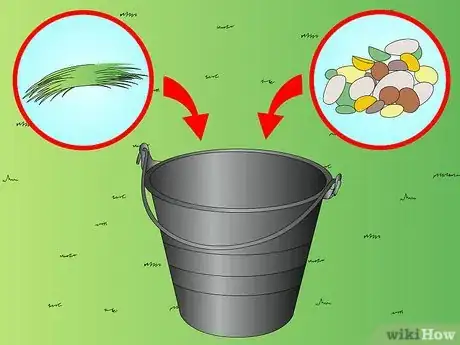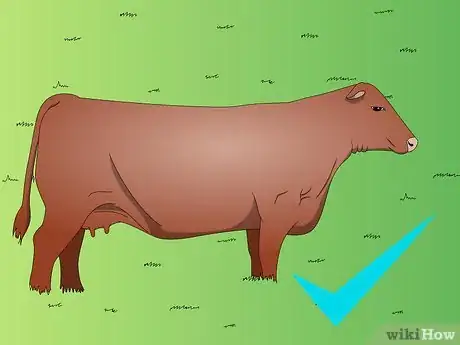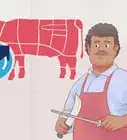X
wikiHow is a “wiki,” similar to Wikipedia, which means that many of our articles are co-written by multiple authors. To create this article, 10 people, some anonymous, worked to edit and improve it over time.
This article has been viewed 50,007 times.
Learn more...
Often using machinery for reseeding pastures isn't as cost effective as you wish it to be, especially with high fuel prices and maintenance or rent costs to rent machinery to seed your pastures with. Knowing how to seed your pastures without the use of machinery can be helpful in keeping costs down for grazing cattle.
Steps
-
1Pour some grass and/or legume seeds into a bucket. Grass and legume seeds would be of any species you've chosen to seed your pastures with, depending on your location. Put as much in as you can comfortably carry, depending on how far you have to carry it or how big of an area you want to seed at one time.
-
2Enter the pasture where the cows are grazing. Move quietly and calmly among them, taking your time to gently scatter the seeds around their feet and over the whole area of the pasture.
- The cows will push the seed into the soil with their hooves and naturally fertilize the area with the waste they excrete.
Advertisement -
3Do this for each pasture, when the cows are grazing in that area.
- Pay special attention to areas that suffer from high traffic areas, such as near and around watering areas, gates, etc.
- Please note that you may find that growing grass in this area will be much more difficult because these areas see a lot of hoof traffic, much more than out in the pasture. This could make it harder for the seeds to grow properly into grass or legume plants.
- Pay special attention to areas that suffer from high traffic areas, such as near and around watering areas, gates, etc.
Advertisement
Community Q&A
-
QuestionHow can I get seed to plant for my cattle?
 KarinTop AnswererYour local forage seed distributor or supplier is the best place to start. They will have various species available for you to choose from, and ideally you should aim to have at least 3 species to sow into your pasture--and those three or more should be ones adapted to your area. The percent seed in the bag is what's in the bag only, not what plants are going to come up. For instance, if there's 10% timothy, 30% brome grass and 60% alfalfa, then you should expect almost half of the plant stand to come up as timothy, then alfalfa, then brome grass.
KarinTop AnswererYour local forage seed distributor or supplier is the best place to start. They will have various species available for you to choose from, and ideally you should aim to have at least 3 species to sow into your pasture--and those three or more should be ones adapted to your area. The percent seed in the bag is what's in the bag only, not what plants are going to come up. For instance, if there's 10% timothy, 30% brome grass and 60% alfalfa, then you should expect almost half of the plant stand to come up as timothy, then alfalfa, then brome grass. -
QuestionYou mention an acre per cow; my question is how long of a period would it be able to graze on that acre?
 KarinTop AnswererIt really ultimately depends on how much grass you have, and how much residue you want to leave behind. That's where the "art" of grazing comes into play. Ideally you're not going to dedicate one acre for one cow, rather you should focus on having a herd of cattle on one acre for a short period of time. The less grass you have, the less time they need to spend on that acre, or the more acres are needed for that herd. But the more cattle you have, the greater the chance their hooves can trample in the seeds and open the canopy to allow those seeds to germinate. Just don't let them stay for too long, otherwise that trampling does more bad than good.
KarinTop AnswererIt really ultimately depends on how much grass you have, and how much residue you want to leave behind. That's where the "art" of grazing comes into play. Ideally you're not going to dedicate one acre for one cow, rather you should focus on having a herd of cattle on one acre for a short period of time. The less grass you have, the less time they need to spend on that acre, or the more acres are needed for that herd. But the more cattle you have, the greater the chance their hooves can trample in the seeds and open the canopy to allow those seeds to germinate. Just don't let them stay for too long, otherwise that trampling does more bad than good.
Advertisement
Warnings
- Some may argue that this process is more labor-intensive and time-consuming than mechanized forms of seeding. However, under systems of managed, intensive grazing, smaller areas or whole paddocks can be hand-seeded in short, un-laborious shifts. The key here is to "follow nature," where seed is released slowly and in phases over fairly long periods, dependent on factors such as season, weather conditions, and/or passing cattle.⧼thumbs_response⧽
- Avoid seeding during a time when calving is being done or when you have the bull out with the cows. You could run the risk of getting chased out of the paddock if you're not careful.⧼thumbs_response⧽
Advertisement
Things You'll Need
- Cattle
- Bucket or sack
- Grass/legume seeds
About This Article
Advertisement
























































